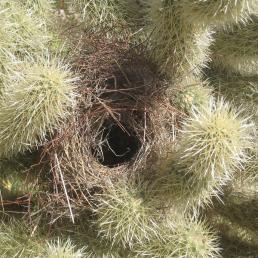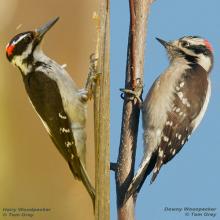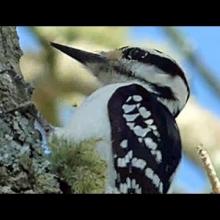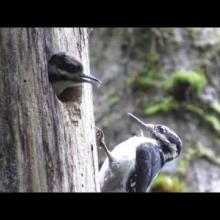

Join BirdNote tomorrow, November 30th!
Illustrator David Sibley and actor H. Jon Benjamin will face off in the bird illustration battle of the century during BirdNote's Year-end Celebration and Auction!
Because many woodpeckers have pointed tongues, it was once assumed that they “harpoon” their prey. But what they actually do is more complex. Like a safe-cracker in a movie, birds like this Hairy Woodpecker use a killer combination of sensitivity and force. First, as it scales a tree trunk, the Hairy Woodpecker taps lightly to locate wood-boring insects. Then it chisels a small opening and slides its long tongue down the insect’s tunnel. Because the woodpecker’s tongue is equipped with barbs and sticky saliva, there’s no resisting its force.
Support for BirdNote comes from American Bird Conservancy and Bringing Back the Birds, a photo book by Owen Deutsch on the importance of protecting birdscapes. Available at amazon.com.
BirdNote®
Do Woodpeckers Harpoon Their Prey?
Written by Bob Sundstrom
This is BirdNote.
[Hairy Woodpecker drumming, http://macaulaylibrary.org/audio/30193, 0.10-.11, repeated]
Because many have pointed tongues, it was once assumed that certain woodpeckers harpoon their prey. But what they actually do is more complex. Like a safe-cracker in a movie, birds like the Hairy Woodpecker use a killer combination of sensitivity and force. [Light tapping on wood; excavation sounds Hairy Woodpecker 126457]
First, as it scales a tree trunk, the Hairy Woodpecker taps lightly here and there. A telltale sign – just the right resonance – lets it know: there’s a tunnel underneath. And where there's a tunnel, there's most likely a tunneler. A wood-boring insect.
Next, the woodpecker chisels a small opening [Heavier whacks of excavation sound] and slides its long tongue down the insect’s tunnel. The tongue-tip likely features taste and touch organs that sense when it hits the bulls-eye.
But how do you get the prey out? Whether beetle, ant, or grub, it's by now most likely braced itself inside the tree. The woodpecker’s tongue is more than up to the job. Its tip is coated with sticky saliva, has backward facing barbs, and can even wrap itself around the prey. So once it's found its mark, there's no resisting its force.
And the prey is done for.
Support for BirdNote comes from American Bird Conservancy and Bringing Back the Birds, a photo book by Owen Deutsch on the importance of protecting birdscapes. Available at amazon.com.
###
Bird sounds provided by The Macaulay Library of Natural Sounds at the Cornell Lab of Ornithology, Ithaca, New York. Hairy Woodpecker drumming [30193] recorded by Oliver H Hewitt; pecking [126457] recorded by T G Sander
BirdNote’s theme music was composed and played by Nancy Rumbel and John Kessler
Producer: John Kessler
Executive Producer: Dominic Black
© 2015 Tune In to Nature.org June 2017/2020 Narrator: Michael Stein
ID# woodpecker-10-2015-06-11woodpecker-10
Villard, Pascal; Cuisin, Jacques (2004). "How do woodpeckers extract grubs with their tongues? A study of the Guadeloupe woodpecker (Melanerpes herminieri) in the French Indies". Auk 121 (2): 509–514. [cited in Tim Birkhead’s Bird Sense]









